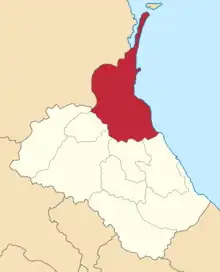Temir-Khan-Shurinsky okrug
Темир-Хан-Шуринскій округъ | |
|---|---|
 Location in the Dagestan Oblast | |
| Country | Russian Empire |
| Viceroyalty | Caucasus |
| Oblast | Dagestan |
| Established | 1867 |
| Abolished | 1922 |
| Capital | Temir-Khan-Shura (present-day Buynaksk) |
| Area | |
| • Total | 6,218.38 km2 (2,400.93 sq mi) |
| Population (1916) | |
| • Total | 136,234 |
| • Density | 22/km2 (57/sq mi) |
| • Urban | 28.48% |
| • Rural | 71.52% |
The Temir-Khan-Shurinsky okrug[lower-alpha 1] was a district (okrug) of the Dagestan Oblast of the Caucasus Viceroyalty of the Russian Empire. The area of the Temir-Khan-Shurinsky okrug is included in contemporary Dagestan of the Russian Federation. The district's administrative centre was Temir-Khan-Shura (present-day Buynaksk).[1]
Administrative divisions
The subcounties (uchastoks) of the Temir-Khan-Shurinsky okrug were as follows:[2]
| Name | 1912 population | Area |
|---|---|---|
| Dzhengutayevskiy uchastok (Дженгутаевскій участокъ) | 33,330 | 720.86 square versts (820.38 km2; 316.75 sq mi) |
| Tarkinskiy uchastok (Таркинскій участокъ) | 9,842 | 1,866.78 square versts (2,124.51 km2; 820.28 sq mi) |
| Temir-Khan-Shurinskiy uchastok (Темир-Хан-Шуринскій участокъ) | 23,174 | 1,134.87 square versts (1,291.55 km2; 498.67 sq mi) |
| Chir-Yurtovskiy uchastok (Чиръ-Юртовскій участокъ) | 5,312 | 1,741.50 square versts (1,981.94 km2; 765.23 sq mi) |
| Tsrist. prom. Kut. (Црист. пром. Кутъ.) | 1,613 | – |
| Pom. N.-ka Tarkin. uch. (Пом. Н.-ка Таркин. уч.) | 15,036 | – |
Demographics
Russian Empire Census
According to the Russian Empire Census, the Temir-Khan-Shurinsky okrug had a population of 97,348 on 28 January [O.S. 15 January] 1897, including 54,052 men and 43,296 women. The majority of the population indicated Kumyk to be their mother tongue, with significant Avar-Andean, Dargin, and Russian speaking minorities.[3]
| Language | Native speakers | % |
|---|---|---|
| Kumyk | 49,730 | 51.08 |
| Avar-Andean | 15,194 | 15.61 |
| Dargin | 9,724 | 9.99 |
| Russian | 9,623 | 9.89 |
| Jewish | 2,787 | 2.86 |
| Nogai | 1,908 | 1.96 |
| Ukrainian | 1,750 | 1.80 |
| Persian | 1,631 | 1.68 |
| Tatar[lower-alpha 2] | 1,261 | 1.30 |
| Polish | 1,024 | 1.05 |
| Armenian | 916 | 0.94 |
| Kazi-Kumukh | 588 | 0.60 |
| Georgian | 241 | 0.25 |
| Lithuanian | 234 | 0.24 |
| German | 189 | 0.19 |
| Chechen | 44 | 0.05 |
| Belarusian | 19 | 0.02 |
| Kyurin | 15 | 0.02 |
| Tat | 4 | 0.00 |
| Other | 466 | 0.48 |
| TOTAL | 97,348 | 100.00 |
Kavkazskiy kalendar
According to the 1917 publication of Kavkazskiy kalendar, the Temir-Khan-Shurinsky okrug had a population of 136,234 on 14 January [O.S. 1 January] 1916, including 72,367 men and 63,867 women, 100,896 of whom were the permanent population, and 35,338 were temporary residents:[6]
| Nationality | Urban | Rural | TOTAL | |||
|---|---|---|---|---|---|---|
| Number | % | Number | % | Number | % | |
| Sunni Muslims[lower-alpha 3] | 76 | 0.20 | 90,840 | 93.24 | 90,916 | 66.74 |
| Russians | 19,478 | 50.19 | 5,522 | 5.67 | 25,000 | 18.35 |
| North Caucasians | 7,109 | 18.32 | 0 | 0.00 | 7,109 | 5.22 |
| Jews | 5,034 | 12.97 | 848 | 0.87 | 5,882 | 4.32 |
| Shia Muslims[lower-alpha 4] | 3,344 | 8.62 | 185 | 0.19 | 3,529 | 2.59 |
| Armenians | 2,064 | 5.32 | 22 | 0.02 | 2,086 | 1.53 |
| Asiatic Christians | 785 | 2.02 | 0 | 0.00 | 785 | 0.58 |
| Other Europeans | 736 | 1.90 | 12 | 0.01 | 748 | 0.55 |
| Georgians | 179 | 0.46 | 0 | 0.00 | 179 | 0.13 |
| TOTAL | 38,805 | 100.00 | 97,429 | 100.00 | 136,234 | 100.00 |
Notes
- ↑
- Russian: Теми́р-Ха́н-Шури́нский о́круг, pre-reform orthography: Теми́р-Ха́н-Шури́нскій о́кругъ, romanized: Temír-Khán-Shurínsky ókrug
- ↑ Before 1918, Azerbaijanis were generally known as "Tatars". This term, employed by the Russians, referred to Turkic-speaking Muslims of the South Caucasus. After 1918, with the establishment of the Azerbaijan Democratic Republic and "especially during the Soviet era", the Tatar group identified itself as "Azerbaijani".[4][5]
- ↑ Primarily Turco-Tatars.[7]
- ↑ Primarily Tatars.[7]
References
- ↑ Tsutsiev 2014.
- ↑ Кавказский календарь на 1913 год, pp. 144–151.
- 1 2 "Демоскоп Weekly - Приложение. Справочник статистических показателей". www.demoscope.ru. Retrieved 2022-07-07.
- ↑ Bournoutian 2018, p. 35 (note 25).
- ↑ Tsutsiev 2014, p. 50.
- ↑ Кавказский календарь на 1917 год, pp. 186–193.
- 1 2 Hovannisian 1971, p. 67.
Bibliography
- Bournoutian, George A. (2018). Armenia and Imperial Decline: The Yerevan Province, 1900–1914. Milton Park, Abingdon, Oxon: Routledge. ISBN 978-1-351-06260-2. OCLC 1037283914.
- Hovannisian, Richard G. (1971). The Republic of Armenia: The First Year, 1918–1919. Vol. 1. Berkeley: University of California Press. ISBN 978-0520019843.
- Кавказский календарь на 1913 год [Caucasian calendar for 1913] (in Russian) (68th ed.). Tiflis: Tipografiya kantselyarii Ye.I.V. na Kavkaze, kazenny dom. 1913. Archived from the original on 19 April 2022.
- Кавказский календарь на 1917 год [Caucasian calendar for 1917] (in Russian) (72nd ed.). Tiflis: Tipografiya kantselyarii Ye.I.V. na Kavkaze, kazenny dom. 1917. Archived from the original on 4 November 2021.
- Tsutsiev, Arthur (2014). Atlas of the Ethno-Political History of the Caucasus (PDF). Translated by Nora Seligman Favorov. New Haven: Yale University Press. ISBN 9780300153088. Archived (PDF) from the original on 17 June 2023.